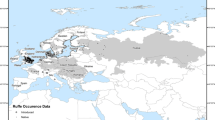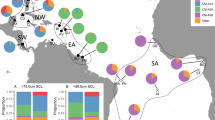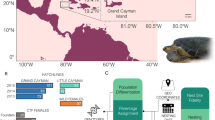Abstract
Green and European Atlantic sturgeon are listed as a vulnerable and a critically endangered species, respectively. These anadromous species inhabit different continents but have many similar life history traits and demographic characteristics, including wide geographic ranges, similar migratory and foraging behavior, age and size structures of reproductive stocks and, historically, diverse population structures. The differences are limited to tetraploid genome and much larger egg size and lower fecundity in green sturgeon, reflecting the adaptations to different geomorphology and biota of the Pacific region. Both species have been affected by over-harvest and habitat losses but the severity of these impacts have been greater and lasted longer for the European Atlantic sturgeon, resulting in loss of diversity and extirpation of all but one stock. From the comparison of human impact on two species we conclude that preventive actions should be taken at the early warning signs of changes in population and recruitment. These should mitigate multiple factors of human activity affecting sturgeon stocks and their habitats.
Similar content being viewed by others
References
Adams PB, Grimes CG, Hightower JE, Lindley ST, Moser MM (2002) Status review for North American green sturgeon. National Marine Fisheries Service, Southwest Fisheries Service Center, Santa Cruz, California
Allen PJ, Cech JJ Jr (2006) Age/size effects on juvenile green sturgeon (Acipenser medirostris) oxygen consumption, growth, and osmoregulation in saline environments. Environ Biol Fish
ASMFC (1998) Amendment 1 to the interstate fishery management plan for Atlantic sturgeon. Atlantic States Marine Fisheries Commission. Fisheries Management Report No. 31. 43 pp, DOI: 10.007/s10641-006-9049-9
Arndt G-M, Gessner J, Anders E, Spratte S, Filipiak J, Debus L, Skora K (2000) Predominance of exotic and introduced species among sturgeons captured from the Baltic and North Seas and their watersheds, 1981–1999. Symposium on conservation of the European Atlantic sturgeon Acipenser sturio L., 1758 in Europe, Madrid, Boletin Instituto Espanol de Oceanografia 16(1–4):29–36
Artyukhin EN, Andronov AE (1990) A morphological study of the green sturgeon, Acipenser medirostris (Chondrostei, Acipenseridae), from the Tumnin (Datta) River and some aspects of the ecology and zoogeography of Acipenseridae. J Ichthyol 30:11–21
Auer NA (2004) Conservation. In: LeBreton GTO, Beamish FWH, McKinley RS (eds) Sturgeons and paddlefish of North America. Kluwer Academic Publishers, Dordrecht, pp 252–276
Beamersderfer RCP, Farr RA (1997) Alternatives for the protection and restoration of sturgeons and their habitat. Environ Biol Fish 48(1–4):407–417
Berg LS (1948) Freshwater fishes of the U.S.S.R. and adjacent countries, Vol I. Izdatelstvo Akademii Nauk SSSR. Translated from Russian by the Israel Program for Scientific Translations, Jerusalem 1962
Billard R, Lecointre G (2001) Biology and conservation of sturgeon and paddlefish. Rev Fish Biol Fish 10:355–392
Birstein VJ, Bemis WE (1997) How many species are there within the genus Acipenser? Environ Biol Fish 48(1–4):147–153
Birstein VJ, Bemis WE, Waldman JR (1997a) The threatened status of Acipenseriform fishes: a summary. Environ Biol Fish 48(1–4):427–435
Birstein VJ, Hanner R, DeSalle R (1997b) Phylogeny of the Acipenseriformes: cytogenetic and molecular approaches. Environ Biol Fish 48(1–4):127–155
Blacklidge KH, Bidwell CA (1993) Three ploidy levels indicated by genome qualification in Acipenseriformes of North America. J Hered 84:427–430
Blankenburg A (1910) Von der Störfischerei in der Elbe. Der Fischerbote 2:7–12 (In German)
Blankenburg A (1913) Bericht über das vorläufige Ergebnis der Untersuchungsfahrt im Interesse der Zucht und der Schonung des Störs im Eidergebiet. Bericht an den Fischereiverein zu Altona 1265/1, 2 pp (In German)
Bonne G (1905) Die Vernichtung der deutschen Flussfischerei durch die Verunreinigung unsrer Gewässer mit besonderer Berücksichtigung der Verhältnisse auf der Unterelbe. Zeitschrift für Fischerei Berlin 12:1–28 (In German)
Boreman J (1997) Sensitivity of North American sturgeons and paddlefish to fishing mortality. Environ Biol Fish 48(1–4):399–405
Brosse L, Rochard E, Dumont P, Lepage M (2000) First results on the diet of the European sturgeon, Acipenser sturio, in the Gironde estuary. Comparison with the benthic fauna. In: Gayet M, Sire JY (eds) First meeting on Ichthyology in France, RIF (2000), Paris, France. Societé-francaise-d’-Ichtyologie 24:(3) 49–61 (In French)
Bruch RM (1999) Management of lake sturgeon on the Winnebago system. Long term impacts of harvest and regulations on population structure. J Appl Ichthyol 15:142–152
Castelnaud G, Rochard E, Jatteau P, Lepage M (1991) Données actuelles sur la biologie d’Acipenser sturio dans l’estuaire de la Gironde. In: Williot P (ed) Acipenser, Actes du premier colloque international sur l’esturgeon. CEMAGREF Publications, Bordeaux, pp 251–275 (In French)
CITES Identification Guide (2001) Sturgeons and paddlefish: guide to the identification of sturgeon and paddlefish species controlled under the Convention on International Trade in Endangered Species of Wild Fauna and Flora. Minister of Supply and Services Canada, ISBN 0-660-61641-6, 181 pp
Classen TEA (1944) Estudo bio-estadistico del sturion o solo del Guadaquivir (Acipenser sturio L.) Ministerio de marina, Intstituto Espanol de Oceanografia, Trabajos 19, Madrid (In Spanish)
Deng X, Van Eenennaam JP, Doroshov SI (2002) Comparison of early life stages and growth of green and white sturgeon. In: Van Winkle W, Anders PJ, Secor DH, Dixon DA (eds) Biology, management and protection of North American sturgeon. American Fisheries Society, Symposium 28, Bethesda, Maryland, pp 237–248
Dettlaff TA, Ginsburg AS, Schmalhausen OI (1993) Sturgeon Fishes, developmental biology and aquaculture. Springer Verlag, Berlin, 300 pp
Doroshov SI, Moberg GP, Van Eenennaam JP (1997) Observations on the reproductive cycle of cultured white sturgeon, Acipenser transmontanus. Environ Biol Fish 48(1–4):265–278
Ehrenbaum E (1916) Zum Antrage auf Erhöhung des gesetzlichen Maßes für den Stör. Fischerbote 8:31–32 (In German)
Elie P (ed) (1997) Restauration de l’esturgeon Europeen Acipenser sturio. Rapport final du programme execution Operations: I–III, 1994–1997. Etude Cemagref 24:381 pp (In French)
Elvira B, Almodovar A (1993) Notice about the survival of sturgeon (Acipenser sturio L., 1758) in the Guadalquivir estuary (S.W. Spain). Arch Hydrobiol 129(2):253–255
Farr RA, Rien TA (2002) Green sturgeon population characteristics in Oregon. Annual Progress Report F-178-R. Oregon Department of Fish and Wildlife, Clackamas, Oregon, 20 pp
Fernandez-Pasquier V (1999) Acipenser sturio L. in the Guadalquivir River, Spain. Water regulation and fishery as factors in stock decline from 1932 to 1967. J Appl Ichthyol 15:133–135
Fontana F (1976) Nuclear DNA content and cytometry of erythrocytes of Huso huso (L.), Acipenser sturio L. and Acipenser naccarii Bonaparte. Caryologia 29:127–138
Fontana F, Tagliavini J, Congiu L (2001) Sturgeon genetics and cytogenetics: recent advancements and perspectives. Genetica 111:359–373
Gessner J (2000) Reasons for the decline of Acipenser sturio L., 1758 in central Europe, and attempts at its restoration. Symposium on Conservation of the European Atlantic sturgeon Acipenser sturio L., 1758 in Europe, Madrid. Boletin Instituto Espanol de Oceanografia 16(1–4):117–126
Gross MR, Repka J, Robertson CT, Secor DH, Van Winkle W (2002) Sturgeon conservation: insights from elasticity analysis. In: Van Winkle W, Anders PJ, Secor DH, Dixon DA (eds) Biology, management and protection of North American sturgeon. American Fisheries Society, Symposium 28, Bethesda, Maryland, pp 13–30
Hagenbeck C (1908) Von Tieren und Menschen. Hamburg (In German)
Hensel E, Kirschbaum F, Gessner J, Williot P, Wirth M (2002) Restoration of Acipenser sturio L, 1758 in Germany: Effect of different food items on specific growth rates of large juvenile fish. Int Rev Hydrobiol 87(5–6):539–551
Holcik J, Kinzelbach R, Sokolov LI, Vasiliev VP (1989) Acipenser sturio Linnaeus, (1758). In: Holcik J (ed) The freshwater fishes of Europe, Vol. 1, Pt. II. AULA-Verlag, Wiesbaden, pp 367–394
Israel JA, Cordes JF, Blumberg MA, May B (2004) Geographic patterns of genetic differentiation among collections of green sturgeon. N Am J Fish Manage 24:922–931
Kasumyan AO (2002) Sturgeon food searching behaviour evoked by chemical stimuli: a reliable sensory mechanism. J Appl Ichthyol 18(4–6):685–690
Kausch H (1996) Fahrwasservertiefungen ohne Grenzen? In: Lozan JL, Kausch H (eds) Warnsignale aus Flüssen und Ästuaren. Verl. Paul Parey, Berlin, pp 162–176 (In German)
Kim DS, Nam YK, Noh JK, Park CH, Chapman FA (2005) Karyotype of North American shortnose sturgeon Acipenser brevirostrum with the highest chromosome number in the Acipenseriformes. Ichthyol Res 52:94–97
Kinzelbach RK (1987) Das ehemalige Vorkommen des Störs, Acipenser sturio (Linnaeus, 1758) im Einzugsgebiet des Rheins (Chondrostei, Acipenseridae). Zeitschr Angewandte Zool 74(2):167–200 (In German)
Kinzelbach RK (1997) The sturgeon (Acipenser sturio Linnaeus, 1758) in Europe. Zeitschr Ökol Natur 6:129–135 (In German)
Kirschbaum F, Gessner J (2000) Re-establishment program for Acipenser sturio L., 1758: the German approach. Symposium on Conservation of the European Atlantic sturgeon Acipenser sturio L., 1758 in Europe, Madrid, Boletin Instituto Espanol de Oceanografia 16(1–4):149–156
Kraeft M (1894) Die Einführung und das Ergebnis der Störfischerei an der hinterpommerschen Ostküste. Mitteilungen der Section für Küsten- und Hochseefischerei des Deutschen Fischerei-Vereins 10(6):142–148 (In German)
Kynard B, Horgan M (2002) Ontogenetic behavior and migration of American Atlantic sturgeon, Acipenser oxyrinchus oxyrinchus, and shortnose sturgeon, A. brevirostrum, with notes on social behavior. Environ Biol Fish 63:137–150
Kynard B, Parker E, Parker T (2005) Behavior of early life intervals of Klamath River green sturgeon, Acipenser medirostris, with a note on body color. Environ Biol Fish 72:85–97
LeBreton GTO, Beamish FWH (2004) Growth, bioenergetics and age. In: LeBreton GTO, Beamish FWH, McKinley RS (eds). Sturgeons and paddlefish of North America. Kluwer Academic Publishers, Dordrecht, pp 195–216
Lepage M, Mayer N, Rochard E, Gonthier P, Guerri O (2003) Fishery By-Catch in the Bay of Biscaye of European Atlantic sturgeon (Acipenser sturio L.). AFS Annual Conference Quebec 2003, Abstract 12879984
Lepage M, Rochard E (1995) Threatened fishes of the world: Acipenser sturio Linnaeus, 1758 (Acipenseridae). Environ Biol Fish 43:28
Ludwig A, Debus L, Lieckfeldt D, Wirgin I, Benecke N, Jenneckens I, Williot P, Waldman JR, Pitra C (2002) When the American sea sturgeon swam east. Nature 419:447–448
Ludwig A, Williot P, Kirschbaum F, Liekfeldt D (2004) Genetic variability of the Gironde population of Acipenser sturio. In: Gessner J, Ritterhoff J (eds) Species differentiation and population identification in the sturgeons Acipenser sturio and Acipenser oxyrinchus. BfN Skripten 101, pp 54–72
Magnin E (1963) Rechèrches sur la systématique et la biologie des Acipenséridae Acipenser sturio L., Acipenser oxyrhynchus Mitchill, et Acipenser fulvescens Rafinesque. Ann Stat Centre Hydrobiol Appl 9:7–244 (In French)
Marti VY (1939) Biology and fishery of Acipenser sturio in the Black Sea. Zool Zhurnal 18:435–442 (In Russian)
Mohler JW (2004) Culture manual for the American Atlantic sturgeon Acipenser oxyrinchus oxyrinchus. U.S. Fish & Wildlife Service, Hadley, Massachusetts, pp 70
Mohr E (1952) Der Stör. Brehm Bücherei, Leipzig, pp 86 (In German)
Moyle PB (2002) Inland fishes of California. Revised and expanded. University of California Press, Berkley
Nakamoto RJ, Kisanuki TT, Goldsmith GH (1995) Age and growth of Klamath green sturgeon (Acipenser medirostris). U.S. Fish and Wildlife Service Project 93-FP-13. Klamath River Fishery Resource Office, Yreka, California
Nellen W, Thiel R, Hölker F, Breckling P (1994) Überlegungen zu fischereilichen Perspektiven der Elbe. Fischer und Teichwirt 7:265–267 (In German)
Niklitschek EJ, Secor DH (2005) Modeling spatial and temporal variation of suitable nursery habitats for American Atlantic sturgeon in the Chesapeake Bay. Estuar, Coast Shelf Sci 64:135–148
Ninua NS (1976) Atlanticheskij osetr reki Rioni. Izdatel’stvo Metsniereba” Tblisi, 121 pp (In Russian)
NOAA (National Oceanic & Atmospheric Administration) (2005) Endangered and threatened wildlife and plants: proposed threatened status for southern distinct population segment of North American green sturgeon. Federal Register 70:65 (April 2005):17386–17401
Quantz H (1903) Störfischerei und Störzucht im Gebiet der deutschen Norseeküste. Mitteilungen des Deutschen Seefischerei-Vereins 19(6):176–204 (In German)
Robinson MR, Ferguson MM 2004 Genetics of North American Acipenserifromes. In: LeBreton GTO, Beamish FWH, McKinley RS (eds) Sturgeons and paddlefish of North America. Kluwer Academic Publishers, Dordrecht, pp 217–230
Rochard E, Castelnaud G, Lepage M (1990) Sturgeons (Pisces: Acipenseriformes), threats and prospects. The Biology and Conservation of Rare Fish: FSBI Symp., Lancaster (UK). J Fish Biol 37(A):123–132
Rochard E, Lepage M, Dumont P, Tremblay S, Gazeau C (2001) Downstream migration of juvenile European sturgeon Acipenser sturio L. in the Gironde estuary. Estuaries 24:108–115
Rochard E, Lepage M, Meauzé L (1997) Identification et charactérisation de l’aire de répartition marine de l’esturgeon européen Acipenser sturio à partir de déclarations de captures. Aquat Living Resour 10:101–109 (In French)
Stevenson JT, Secor DH (2000) Age determination and growth of Hudson River Atlantic sturgeon, Acipenser oxyrinchus. Fish Bull 98:153–166
Tagliavini J, Williot P, Congiu L, Chicca M, Lanfredi M, Rossi R, Fontana F (1999) Molecular cytogenetic analysis of the karyotype of the European Atlantic sturgeon, Acipenser sturio. Heredity 83:520–525
Trouvery M, Williot P, Castelnaud G (1984) Biologie et ecologie d’Acipenser sturio. Etude de la pêcherie. Etude 17, Serie Esturgeon No 1, CEMAGREF Bordeaux, Div. ALA/AGEDRA, 79 pp (In French)
Van Eenennaam AL, Murray JD, Medrano JF (1999) Karyotype of the American green sturgeon. Trans Am Fish Soc 128:175–177
Van Eenennaam JP, Doroshov SI (1998) Effects of age and body size on gonadal development of American Atlantic sturgeon. J Fish Biol 53:624–637
Van Eenennaam JP, Webb MAH, Deng X, Doroshov SI, Mayfield RH, Cech JJ Jr, Hillemeier DC, Willson TE (2001) Artificial spawning and larval rearing of Klamath River green sturgeon. Trans Am Fish Soc 130:159–165
Van Eenennaam JP, Linares-Casenave J, Deng X, Doroshov SI (2005) Effect of incubation temperature on green sturgeon embryos, Acipenser medirostris. Environ Biol Fish 72:145–154
Van Eenennaam JP, Linares J, Doroshov SI, Hillemeier DC, Willson TE, Nova AA (2006) Reproductive conditions of the Klamath River green sturgeon. Trans Am Fish Soc 135:151–163
Williot P, Rochard E, Castlenaud G, Rouault T, Brun R, Lepage M, Elie P (1997) Biological characteristics of European Atlantic sturgeon, Acipenser sturio, as the basis for a restoration program in France. Environ Biol Fish 48:59–370
Williot P, Arlati G, Chebanov M, Gulyas T, Kasimov R, Kirschbaum F, Patriche N, Pavlovskaya LP, Poliakova L, Pourkazemi M, Kim Y, Zhuang P, Zholdasova IM (2002) Status and management of Eurasian sturgeon: An overview. Int Rev Hydrobiol 87:483–506
Wirgin I, Waldman J, Stabile J, Lubinsky B, King T (2002) Comparison of mitochondrial DNA control region sequence and microsatellite DNA analyses in estimating population structure and gene flow rates in American Atlantic sturgeon Acipenser oxyrinchus. J␣Appl Ichthyol 18(4–6):313–319
Author information
Authors and Affiliations
Corresponding author
Rights and permissions
About this article
Cite this article
Gessner, J., Van Eenennaam, J.P. & Doroshov, S.I. North American Green and European Atlantic Sturgeon: Comparisons of Life Histories and Human Impacts. Environ Biol Fish 79, 397–411 (2007). https://doi.org/10.1007/s10641-006-9073-9
Received:
Accepted:
Published:
Issue Date:
DOI: https://doi.org/10.1007/s10641-006-9073-9




